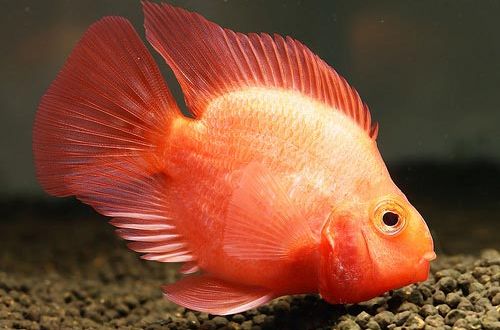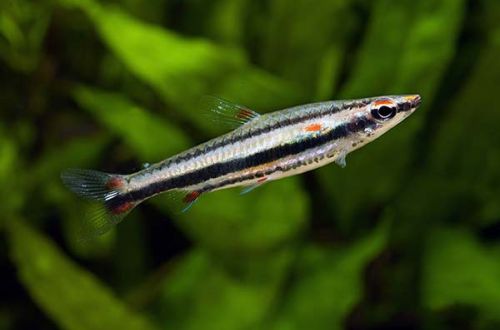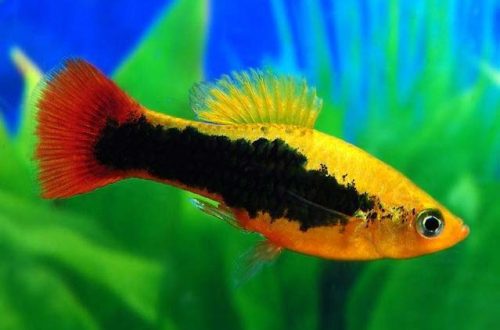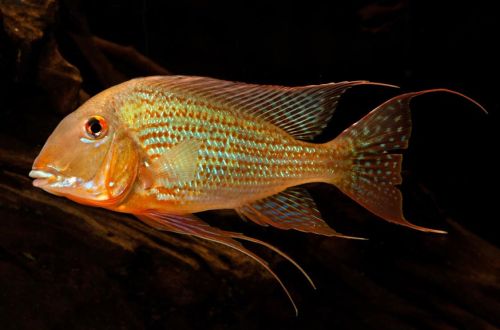
Geofagus altifrons
Geophagus altifrons, scientific name Geophagus altifrons, belongs to the Cichlidae family. A relatively large fish that needs a large spacious aquarium, it is also very demanding on the conditions of detention. All this makes it not the best choice for a beginner aquarist.

Contents
Habitat
It comes from South America from the Rio Negro basin. Inhabits the lower reaches of rivers and floodplain lakes with sand and silt substrates. Prefers to stay close to the shore in regions with clear water (not muddy).
Brief information:
- The volume of the aquarium – from 500 liters.
- Temperature – 26-32°C
- Value pH — 4.8–6.6
- Water hardness – 0–5 dGH
- Substrate type – sandy
- Lighting – subdued
- Brackish water – no
- Water movement is weak
- The size of the fish is 20–22 cm.
- Food – small sinking food from a variety of products
- Temperament – peaceful
- Keeping in a group of 5-8 individuals
Description
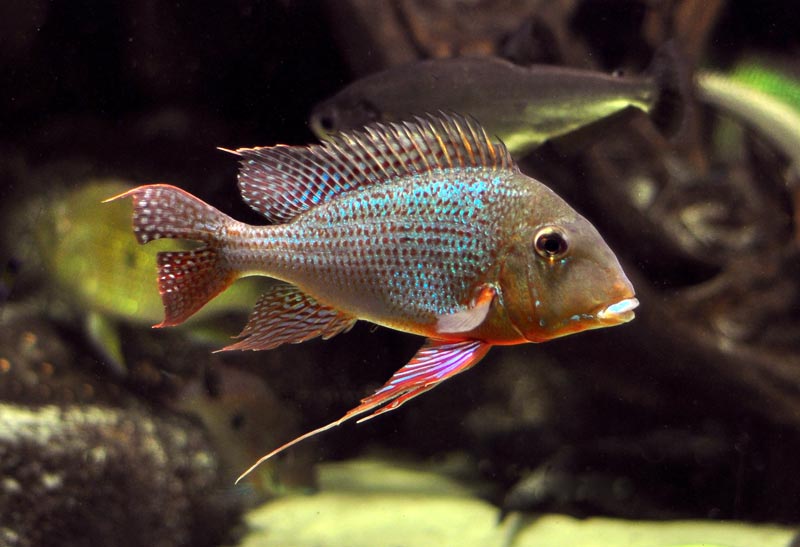
Adults reach a length of 20-22 cm. Depending on the region of origin, the color varies from reddish-orange to blue. Although a number of researchers explain the color palette by the presence of several subspecies, but at the time of writing, they were all classified as Geophagus altifrons. Sexual dimorphism is weakly expressed. Outwardly, there are no obvious differences between male and female.
Food
It feeds near the bottom, sifting sand through its mouth and gills in search of small zoo- and phytoplankton. Sandy soil is indispensable for the normal feeding of this species. Feed sinking food, and food particles should be small. Fish are not able to eat large pieces, despite their small size. The diet may look like this: dry flakes and / or granules with herbal supplements in combination with frozen brine shrimp, daphnia, bloodworm pieces.
Maintenance and care, arrangement of the aquarium
Long-term keeping is possible in aquariums from 500 liters, which will be enough for a group of 3-4 fish. In the design, the substrate is of key importance, as noted above, sandy soil is required. Rough materials, as well as gravel, small pebbles will interfere with normal eating and can get stuck in the mouth. A few snags in the form of tree roots and branches will serve as additional design elements. The use of live or artificial plants is not recommended. Most likely they will be quickly dug up.
Water conditions have a rather narrow acceptable range of hydrochemical values - low hardness and high acidity. In this case, the water should contain a large amount of dissolved tannins. In nature, these substances turn the water of the Rio Negro river brown. In the aquarium, the dried leaves of some trees will become a source of tannins, in particular tannins. Read more about this in the article “Which tree leaves can be used in an aquarium.”
Maintaining high water quality largely depends on its weekly replacement with fresh water in the amount of 50–70%, as well as on the performance of the filtration system. The model and location of the filter should minimize the likelihood of ingress of sand, the clouds of which are obligated at each feeding.
Behavior and Compatibility
Peaceful calm fish if they are in a group of 5-8 individuals in a spacious aquarium. With fewer numbers and in cramped conditions, the dominant alpha male may attack weaker individuals. It is calm with other species, however, too small fish (about 1 cm) and their fry can be accidentally eaten.
Breeding / breeding
The fish are successfully bred in aquariums. Apparently, in the artificial environment there is no specific incentive to start spawning, so the mating season can come at any time.
At the end of a short courtship period, the male and female choose a site on the bottom that will serve as their temporary breeding territory. The female lays eggs in batches on some surface, such as a snag or a large flat stone. After fertilization, he immediately takes them into his mouth and releases a new batch. In total, up to 200 eggs can be laid and all of them will be placed in the mouth, where they will spend the entire incubation period. Carrying eggs in the mouth is a special strategy for protecting future offspring, which is characteristic of many cichlids, including far beyond the South American continent. When the fry are born for the first time, they will continue to be in their shelter and will begin to leave it only on days 8–11, but at the same time they will continue to be near the female. The male stays close all this time, patrolling the territory. It is worth noting that sometimes the roles in a pair change and the male is already engaged in bearing offspring, and the female guards them.
Fish diseases
The main cause of diseases lies in the conditions of detention, if they go beyond the permissible range, then immunity suppression inevitably occurs and the fish becomes susceptible to various infections that are inevitably present in the environment. If the first suspicions arise that the fish is sick, the first step is to check the water parameters and the presence of dangerous concentrations of nitrogen cycle products. Restoration of normal/suitable conditions often promotes healing. However, in some cases, medical treatment is indispensable. Read more about symptoms and treatments in the Aquarium Fish Diseases section.



